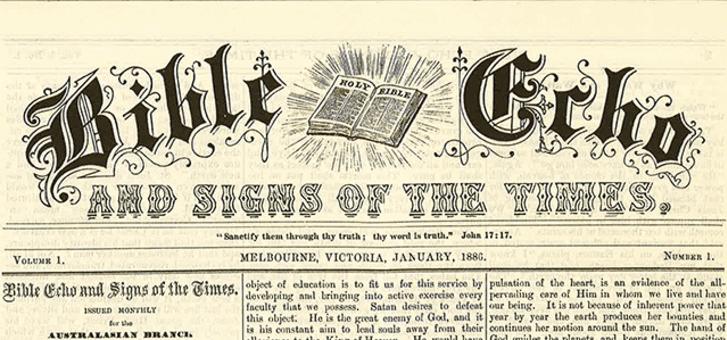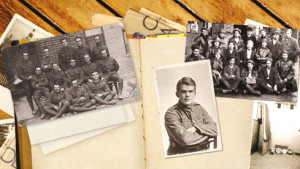In 1885, a small group of the fledgling Seventh-day Adventist Church stepped off the Sydney train at Melbourne’s Spencer Street Station, They hadn’t been in Australia for more than a few days and at once started to look for lodgings and a place from which to operate as Christian evangelists.
Among the new arrivals from the United States was a printer who was central to the group’s outreach strategy, as the production of tracts, booklets and books was key in their ambitious plan to take the gospel message to the scattered populations of Australia, New Zealand and the South Pacific region.

So it was that in January 1886, the first print run of a new magazine was completed and given away on street corners to anyone who showed interest. The Bible Echo and Signs of the Times was laboriously printed on a hand press; each large page full to the brim with comprehensive articles on Bible prophecy, fundamental Christian beliefs and social morality. The lead article, “Science and the Bible in Education” ran over the first two pages. The type was small and cramped by today’s newspaper standards, the columns narrow and there were no illustrations to break the monotony. The editorial on page 8 stated that this new publication would “advocate nothing that is not distinctly taught in Scripture” and that it would be “a chronicler of events which mark the times pointed out in the prophecies.” And because the content was different from anything else on the streets, the editor noted that he expected plenty of comment from the public. Would anyone read it?
“Is Protestantism True to Itself?” was the headline on the next print run and was a not-so-subtle jab at the religious controversy then consuming Melbourne. It was the first time the publication considered a contemporary event, thus setting a benchmark for reporting that would continue 120 years. Another lengthy article focused on the then publicly contentious issue of Sabbath-keeping. Advertisements promoted Bible meetings to be held in a tent on a corner block in North Fitzroy, not far from where The Bible Echo was being printed.

By 1896, The Bible Echo and Signs of the Times was no longer given away. Rather, it sold for a penny and had been reduced from 16 to eight pages. Though smaller, it was still crammed full of information, but with the occasional engraving now providing relief from the dense text. One lead article, uncannily resonating with the condition of today’s world, stated unequivocally that “we are [surely] living in eventful days and troublous times ... . with war between China and Japan ... massacres in Turkey ... trouble between England and the United States... .”
By the end of the century The Bible Echo had become a newspaper and conscience to the general public and a “family” newsletter to a growing population of Christian believers.
A Move For The Best
 In 1906, and for a number of reasons including access to hydro-electric power, the publishing house was moved to Warburton, a small timber-milling village in Melbourne’s upper Yarra Valley, at the foot of Mount Donna Buang. The magazine, now 20 years old, had simplified its name to Signs of the Times, as it is still known.
In 1906, and for a number of reasons including access to hydro-electric power, the publishing house was moved to Warburton, a small timber-milling village in Melbourne’s upper Yarra Valley, at the foot of Mount Donna Buang. The magazine, now 20 years old, had simplified its name to Signs of the Times, as it is still known.
While there were significant changes in style, the focus of the magazine remained intact—to interpret world and local events through a Christian and prophetic perspective. By 1910 the Signs had shrunk again, this time to 12 standard A4 pages and included photographs, but retained the one-penny price.
The reduced content, however, reflected previous issues, but with condensed comments rather than long reports on world issues. Problems in China, both politically and with the opium trade, was a popular topic during the year, and lifestyle features, such as “How to Be Popular,” began to appear.

In the 1920s, following the horrors of World War I, Signs concentrated on continued world trauma as flood surges ravaged Arkansas after a massive hurricane. The editors were offended by the “growing stream of impure literature” and the prophetic implications in “Our Seething Planet” were as plain as “the cancer of lawlessness and unrest is rapidly spreading over the world.”
 The year 1939 was a similar time of uncertainty as the world, after the Great Depression, lurched toward armed conflict in Europe. The editorial of the October 16, 1939, issue pondered the possibility of Germany breaking the Maginot Line in France (the war had broken out on September 3), while the headline article was on a growing belief in evolution. Before the end of the year, the world was at war and Signs featured one full page devoted to nothing else but the Bible text, “Let not your heart be troubled ...” On the following page was a sentence that could have been lifted from today’s media: “Millions of human beings in our troubled world tremble ...” staggering world event dominated the January 1, 1946 issue. The atomic bomb had ended the war in the Pacific and the Signs wondered whether “science has gone too far.” The report concluded that there was something “greater than the atom,” that being the promise of salvation in Jesus Christ. This continual attachment of spiritual assurance to catastrophe set Signs apart from other papers of the day.
The year 1939 was a similar time of uncertainty as the world, after the Great Depression, lurched toward armed conflict in Europe. The editorial of the October 16, 1939, issue pondered the possibility of Germany breaking the Maginot Line in France (the war had broken out on September 3), while the headline article was on a growing belief in evolution. Before the end of the year, the world was at war and Signs featured one full page devoted to nothing else but the Bible text, “Let not your heart be troubled ...” On the following page was a sentence that could have been lifted from today’s media: “Millions of human beings in our troubled world tremble ...” staggering world event dominated the January 1, 1946 issue. The atomic bomb had ended the war in the Pacific and the Signs wondered whether “science has gone too far.” The report concluded that there was something “greater than the atom,” that being the promise of salvation in Jesus Christ. This continual attachment of spiritual assurance to catastrophe set Signs apart from other papers of the day.

The potential of global nuclear war came under scrutiny in 1956. In a number of references to Armageddon, the Signs, now a popular two-colour magazine costing tuppence, showed pictures of people furiously digging bomb shelters as a fearful Cold War obsessed the world. The Signs urged readers to think beyond the fear.
The 60s and 70s

Colour covers, rather insipid by today’s standards, featured in the following decade. More personality profiles appeared in print and a regular feature entitled “The Meaning of Events” was a popular segment. The layout of the magazine was typically “1960s,” moving away from an overuse of text to the utilisation of space and original illustrations clearly reflecting the culture of the day. Page layout moved to a three-column format, in spite of strong pressure not do this as it was deemed “modern and American.” The articles were changing in nature, too, becoming more “chatty,” but without losing the spiritual punchiness of earlier issues.
 The 1970s was a decade of technological innovation. Offset presses and punched-tape typesetting changed the face of the printing industry. Suddenly there was more freedom in layout and design and this was reflected, albeit slowly, in the production of Signs of the Times. In content, the magazine had so many regular segments that they almost overwhelmed feature stories. A vast array of experienced writers contributed month-by-month in one-page Q&A Bible studies, Scripture-based homilies, poems, lifestyle and medical questions answered, quizzes of all kinds and a page for children. This decade saw the greatest subscription level in the history of the magazine, with some 75,000 printed monthly.
The 1970s was a decade of technological innovation. Offset presses and punched-tape typesetting changed the face of the printing industry. Suddenly there was more freedom in layout and design and this was reflected, albeit slowly, in the production of Signs of the Times. In content, the magazine had so many regular segments that they almost overwhelmed feature stories. A vast array of experienced writers contributed month-by-month in one-page Q&A Bible studies, Scripture-based homilies, poems, lifestyle and medical questions answered, quizzes of all kinds and a page for children. This decade saw the greatest subscription level in the history of the magazine, with some 75,000 printed monthly.
Changing With The Times

But the days when people read for leisure were in decline. Television was now firmly entrenched in nearly every home. People began to watch rather than read. To counter this decline in readership and stay competitive with the rising sophistication of popular magazines, a significant change in format took place in 1991 when the Signs moved to a smaller size, albeit with 64 pages. This was a calculated marketing risk as the core subscriber base, generally conservative and ageing, had become comfortable over the years with the familiar larger size. The smaller “Reader’s Digest” shape evolved slowly into a tacit acceptance that it was a necessary (and ultimately successful) stratagem. As late as 2000, people were still heard to refer to “the new size” of the Signs.
As gently as possible, the size change was accompanied by a deliberate move to highlight personalities on the cover—a positive role-model philosophy—and to freshen up the layout with computer-graphic design. Contents included more health and lifestyle features to compensate for the demise of a sister publication, Good Health. This provoked some criticism that the traditional doctrinal and prophetic messages were being diluted. Not so! Only the packaging was different.
Today’s Signs of the Times is a colourful, classy, even trendy magazine that wears with pride the heritage of 120 years. It has won accolades for both editorial content, individual articles and creative illustration. And it even has its own website— www.signsofthetimes.org.au.
It would be fair to say that the Signs of the Times magazine has enriched and often changed the lives of thousands of individuals in Australia and New Zealand since its inception in 1886. A conservative estimate suggests that at least 25 million copies have been printed over that time, not including the occasional special large-run edition. Marketing and sales have moved from free handouts on busy Melbourne streets to illuminated lightboxes in airports, national subscription campaigns and magazine racks inside and outside shops and facilities across the Pacific.
Times, tastes and values change. But the basic philosophy underpinning the Signs of the Times has remained constant just as the presentation has evolved so as to connect with the public. The original editorial viewpoint that the magazine should “advocate nothing that is not distinctly taught in Scripture” and that it would be “a chronicler of events which mark the times pointed out in the prophecies” is still as valid today as it was when the first edition was printed. It needs to be.
Today’s global village is more hazardous, more unpredictable and anxiety-ridden than any age in history. If there was ever a time for Christian reflection on local and international events and their relationship to Bible prophecy, it is now. As a constant in this hectic world, Signs of the Times continues to offer comfort, assurance and hope. It’s telling the world—as it always has—that God loves us, and wants the best for our lives and our world.





